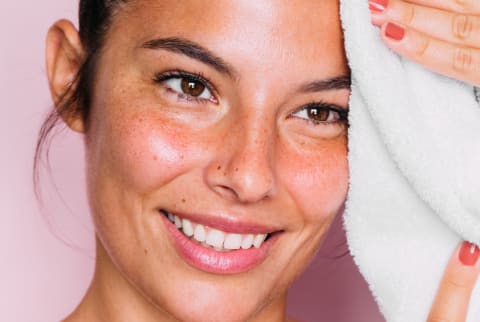Advertisement
Towels Can Act As A Physical Exfoliant: Here's What To Know


There's significant confusion surrounding exfoliation. Rightfully so, given how many variables there are. Even if the premise is simple (removing excess dead skin cells from the stratum corneum, or outermost layer of the skin), in practice there's quite a bit to it. To start, there are the two types of exfoliation—physical and chemical—which differ in how they slough off those cells. Then you get into potency and strength, which is a sliding scale that runs the gamut. Of course, there are questions of regularity and how often exfoliation is appropriate. Finally, there's the skin itself: How easily irritated or tolerant is the skin type to begin with? These variants all amount to a very confusing skin care step.
That's unfortunate because exfoliation is a practice you really shouldn't get wrong: Doing it too much or too aggressively will wreak havoc on the skin. "Overexfoliation can strip the skin of its natural oils, which can lead to more breakouts," says board-certified dermatologist Raechele Cochran Gathers, M.D. "Overexfoliating can also lead to irritation, redness, and inflammation of the skin.”
It is with this that we regret to inform you that you may, in fact, already be doing just that—and the culprit comes from a very sneaky place.
PSA: Your towel can act as a physical exfoliant.
A physical exfoliant is any product, treatment, or tool that manually sloughs off the dead skin cells. They're most often associated with scrubs, which are made with granular ingredients to buff away skin. However, face brushes (electronic or otherwise) and loofahs are also exfoliants. And finally: So is your towel.
Traditional towels are made of woven or waffled cotton: Even the plushest options can scrape away skin when pressure is applied too firmly or you use it too aggressively. So when you go to dry your face post-wash, you may be unknowingly ridding yourself of your protective stratum corneum layer. This is potentially problematic because you are likely using it once, perhaps even twice or three times, a day. Sure, we know that everyone requires a different level of exfoliation, but that is certainly too much, regardless of your skin type.
Scared this might be you? Well, telltale signs are skin that is blotchy, tight, or stings post-wash, and it may even appear red or ashy. And when this happens too frequently, that irritation may become chronic—meaning your skin is regularly inflamed and develops new sensitivities.
I know it's common to equate a squeaky skin feeling with cleanliness, but stop: Skin should feel and appear supple and soft post-wash, not strained and bone dry.
The fix: Try microfiber or muslin cloth, and please be gentle.
The first thing to do is simply acknowledge and understand that rough towel usage can affect your skin barrier function. Now that you know your towel may be doing some harm, you'll likely adjust your drying techniques. As for said techniques: Pat dry; never pull or scrub. Blotting will remove water without irritating the skin—as well as leaving some of that much-needed moisture on top.
You may also consider upgrading your face towel, to a muslin or microfiber option. Muslin cloths are made of 100% cotton fabric. They're multilayered and finely woven, making them extremely soft on the skin. "Even the softest washcloth is still not as soft and gentle as a muslin cloth," says board-certified dermatologist Hadley King, M.D. Microfiber towels use tiny, tiny fibers (no larger than the diameter of a strand of silk), so they are incredibly smooth—as well as absorbent, so they are able to more readily soak in that water, without as much effort on your end.
The takeaway.
If your skin is constantly irritated and you just can't seem to find out why? Put down the towel. That little item may be doing more harm than it's worth. The good news is that the fix is simple: Stop being so rough with your skin—and perhaps even invest in a new, softer option.